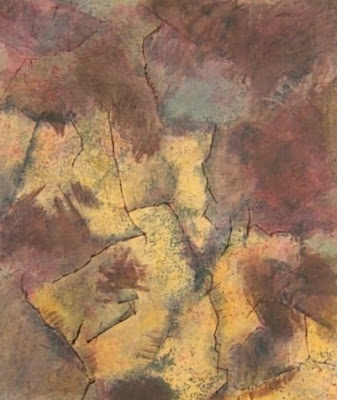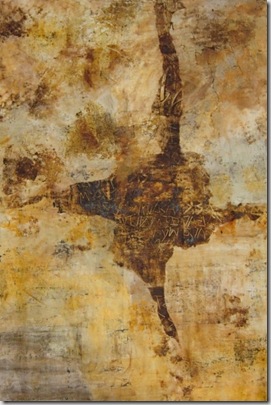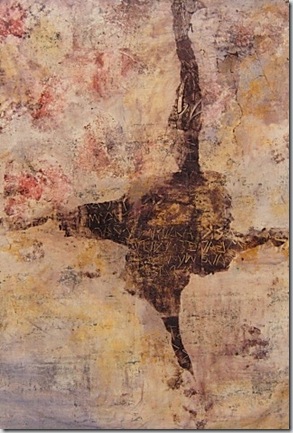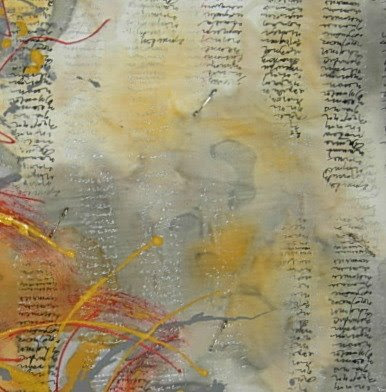
Who knew clearing and sorting could be so -- introspective?!?!? This silk painted scarf is from a water soluble resist class with Christine Zoller at QSDS in 2001 -- can you believe that I, who can't remember most places, dates and names, remember exactly when, where and with whom I
made this sample?!?! And that I've saved it -- and all my other such class samples -- for nearly 14 years??
Going through the boxes and piles of samples, I could actually organize and map out the trail of my development as a surface designer and artist through the entire array of surface design techniques. And make all of you who are just beginning down this trail feel oh so good at how oh so unpolished and rough most of them are!! How does one get color, pattern or texture on a piece of cloth? I've studied and practiced such a variety of ways that it dizzies me to even go through these that I have done so much work in so many directions.
I have a friend who took a silk painting class 14 years ago and she's been silk painting ever since. Silk painting is all does and she does it beautifully. A singular focus. Wow, how did I miss that gene??
In contrast, I went on an extended, around the world cruise of surface design techniques. Why? I have always envisioned each technique as richer when combined with another one. The desire to mix mediums seems to be in my DNA; and you can't mix them if you don't know how to do them. So I studied the techniques that I was most drawn to; not just took classes, but came back and worked with the techniques through hundreds of yards of cottons and silks.
The common threads that seem to run through all these various stages in my explorations and fascinations? It boils down primarily to three.
The first is texture, probably a given for a person who chooses to work with textiles -- and trust me, I've tried just about every conceivable tool and technique to layer and build textural surfaces with dye, paint, free motion embroidery and hand stitching. What a versatile medium, who could
NOT fall under its spell??
The second focus is mark. Initially, like so many other textile people, I seemed to breathe and exhale repeating patterns, but then I realized I was actually just making -- well, fabric. As in cut it up and use it for garments or wall hangings
yardage. My
desire was to create compositions on my cloth -- paintings with the addition of stitching to define and add those textural elements that I seem to crave.
The third area of focus is meaning. Making art is about making meaning, as my friend and author Terry Barrett writes. I tend to think it as a plot or story because of my writing background. What story do I wish to tell with my work, what are the thoughts and ideas behind the compositional choices that I make? When children read, there are beautiful illustrations that make the story quite clear. Words are almost secondary because the images reveal the story.
However, only the suggestions of the story need to be present in visual art. I don't want to make them so obvious you say -- oh yeah, there is Goldilocks and there are the three bears. I want the story to be suggested or implied rather than explicit. Ideally, the composition reveals suggestions and clues for the story within the work. Am I intentionally "hiding" the meaning in the surfaces? No, but sometimes the meanings are private and I want to only reveal a little and let the viewer create their own story from looking at it.
I realize there's been a progression in my self-designed "graduate studies" in fiber art and that I've entered a new phase. Now the real work has begun, digging deeper into the conceptual side of the work, refining the ways I tell each "story", distilling the ideas and techniques into a clear and powerful personal perspective. THAT is a challenge every artist faces.
Since I believe that creativity is inherent and that every individual is a unique expression of creative energy, my "job" is to allow that expression from deep within myself to grow and expand and refine through practice and experience. The more I allow and trust, the more that powerful personal voice can grow.
It's a life's work and passionate engagement. Which does remind me that I had best finish the mundane sorting and cleaning these closets so I can get back to it!
 The lit cases hold shelves of small painted steel structures created from the twenty-six letters in the Roman alphabet as well numerals 0-9.
The lit cases hold shelves of small painted steel structures created from the twenty-six letters in the Roman alphabet as well numerals 0-9. These displays of tiny white maquettes captured my imagination immediately, first because the pencil lines of the artist's sketching were apparent and I could see the slight corrections he made before cutting them and second, because they reveal a sense of creative play that seems to characterize much of Benton's sculptural works.
These displays of tiny white maquettes captured my imagination immediately, first because the pencil lines of the artist's sketching were apparent and I could see the slight corrections he made before cutting them and second, because they reveal a sense of creative play that seems to characterize much of Benton's sculptural works.

























